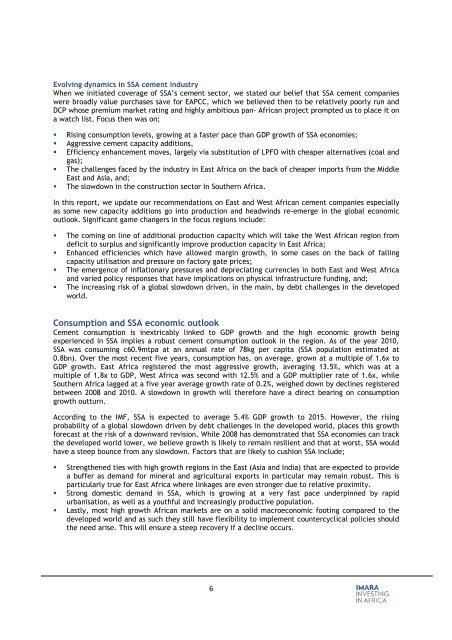East and West Africa Cement Companies Report November 2011
East and West Africa Cement Companies Report November 2011
East and West Africa Cement Companies Report November 2011
Create successful ePaper yourself
Turn your PDF publications into a flip-book with our unique Google optimized e-Paper software.
Evolving dynamics in SSA cement industry<br />
When we initiated coverage of SSA’s cement sector, we stated our belief that SSA cement companies<br />
were broadly value purchases save for EAPCC, which we believed then to be relatively poorly run <strong>and</strong><br />
DCP whose premium market rating <strong>and</strong> highly ambitious pan- <strong>Africa</strong>n project prompted us to place it on<br />
a watch list. Focus then was on;<br />
� Rising consumption levels, growing at a faster pace than GDP growth of SSA economies;<br />
� Aggressive cement capacity additions,<br />
� Efficiency enhancement moves, largely via substitution of LPFO with cheaper alternatives (coal <strong>and</strong><br />
gas);<br />
� The challenges faced by the industry in <strong>East</strong> <strong>Africa</strong> on the back of cheaper imports from the Middle<br />
<strong>East</strong> <strong>and</strong> Asia, <strong>and</strong>;<br />
� The slowdown in the construction sector in Southern <strong>Africa</strong>.<br />
In this report, we update our recommendations on <strong>East</strong> <strong>and</strong> <strong>West</strong> <strong>Africa</strong>n cement companies especially<br />
as some new capacity additions go into production <strong>and</strong> headwinds re-emerge in the global economic<br />
outlook. Significant game changers in the focus regions include:<br />
� The coming on line of additional production capacity which will take the <strong>West</strong> <strong>Africa</strong>n region from<br />
deficit to surplus <strong>and</strong> significantly improve production capacity in <strong>East</strong> <strong>Africa</strong>;<br />
� Enhanced efficiencies which have allowed margin growth, in some cases on the back of falling<br />
capacity utilisation <strong>and</strong> pressure on factory gate prices;<br />
� The emergence of inflationary pressures <strong>and</strong> depreciating currencies in both <strong>East</strong> <strong>and</strong> <strong>West</strong> <strong>Africa</strong><br />
<strong>and</strong> varied policy responses that have implications on physical infrastructure funding, <strong>and</strong>;<br />
� The increasing risk of a global slowdown driven, in the main, by debt challenges in the developed<br />
world.<br />
Consumption <strong>and</strong> SSA economic outlook<br />
<strong>Cement</strong> consumption is inextricably linked to GDP growth <strong>and</strong> the high economic growth being<br />
experienced in SSA implies a robust cement consumption outlook in the region. As of the year 2010,<br />
SSA was consuming c60.9mtpa at an annual rate of 78kg per capita (SSA population estimated at<br />
0.8bn). Over the most recent five years, consumption has, on average, grown at a multiple of 1.6x to<br />
GDP growth. <strong>East</strong> <strong>Africa</strong> registered the most aggressive growth, averaging 13.5%, which was at a<br />
multiple of 1.8x to GDP, <strong>West</strong> <strong>Africa</strong> was second with 12.5% <strong>and</strong> a GDP multiplier rate of 1.6x, while<br />
Southern <strong>Africa</strong> lagged at a five year average growth rate of 0.2%, weighed down by declines registered<br />
between 2008 <strong>and</strong> 2010. A slowdown in growth will therefore have a direct bearing on consumption<br />
growth outturn.<br />
According to the IMF, SSA is expected to average 5.4% GDP growth to 2015. However, the rising<br />
probability of a global slowdown driven by debt challenges in the developed world, places this growth<br />
forecast at the risk of a downward revision. While 2008 has demonstrated that SSA economies can track<br />
the developed world lower, we believe growth is likely to remain resilient <strong>and</strong> that at worst, SSA would<br />
have a steep bounce from any slowdown. Factors that are likely to cushion SSA include;<br />
� Strengthened ties with high growth regions in the <strong>East</strong> (Asia <strong>and</strong> India) that are expected to provide<br />
a buffer as dem<strong>and</strong> for mineral <strong>and</strong> agricultural exports in particular may remain robust. This is<br />
particularly true for <strong>East</strong> <strong>Africa</strong> where linkages are even stronger due to relative proximity.<br />
� Strong domestic dem<strong>and</strong> in SSA, which is growing at a very fast pace underpinned by rapid<br />
urbanisation, as well as a youthful <strong>and</strong> increasingly productive population.<br />
� Lastly, most high growth <strong>Africa</strong>n markets are on a solid macroeconomic footing compared to the<br />
developed world <strong>and</strong> as such they still have flexibility to implement countercyclical policies should<br />
the need arise. This will ensure a steep recovery if a decline occurs.<br />
6


